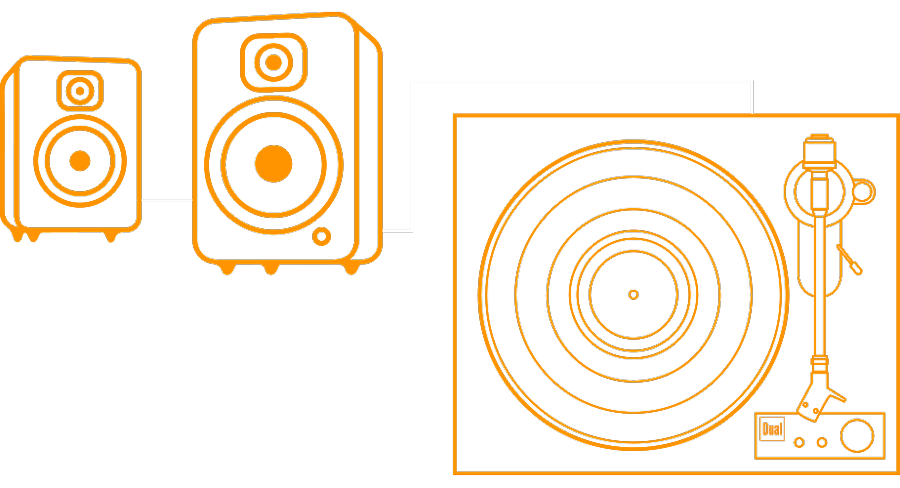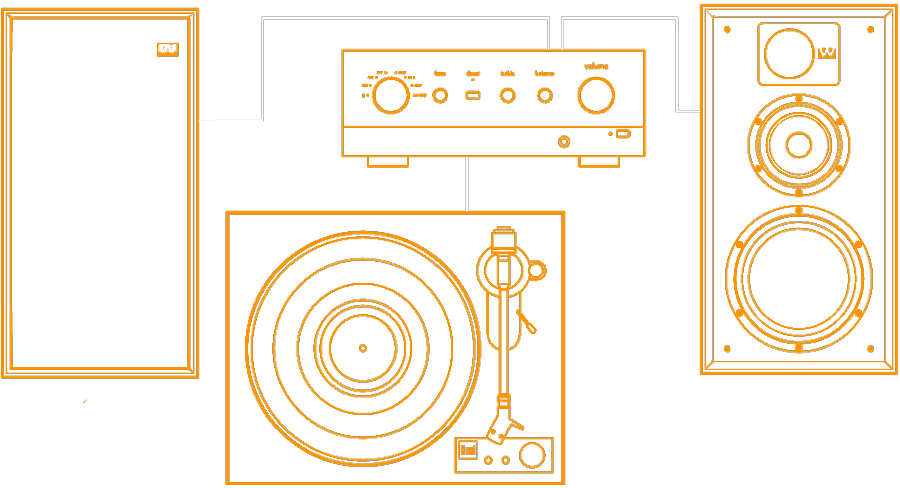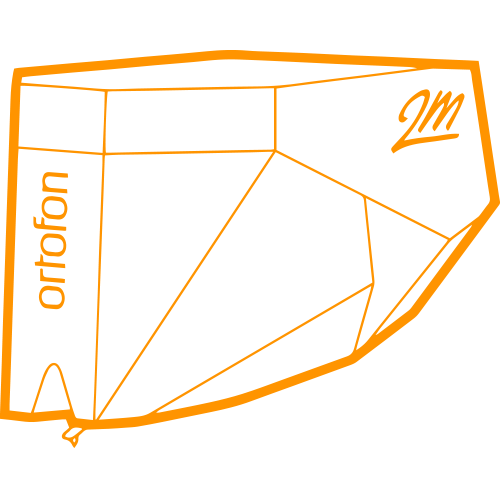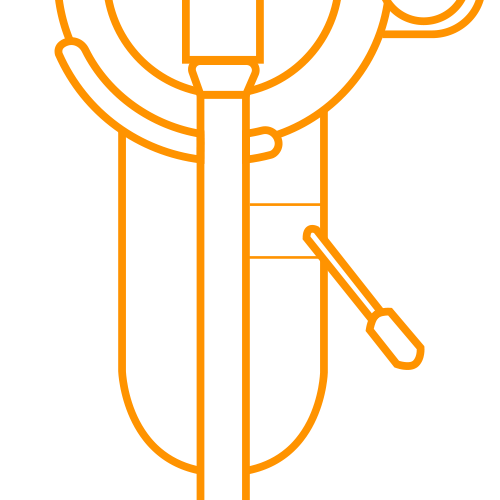Buying your First turntable
Invest in Sound Quality - Your First Turntable Guide
Traditionally, playing records required four separate components. However, today, many of these components are combined. All Dual turntables include phono preamplifiers, and many home speakers now include amplifiers. So, the most common setups are the following:
Turntable with Powered Speakers:

Turntable with Separate Components:

Beginner's Toolkit: Demystifying Turntable Technology.
The circular, flat surface spinning atop your turntable is the platter. It’s designed to spin your record in a fixed, stable position. The plinth is the body of the turntable by which the platter spins atop. It isolates your record and cartridge from external vibration that negatively affect sound quality.

Cartridge & stylus are two parts of a single component, positioned at the end of the tonearm, responsible for reading and translating vinyl record information. The stylus drags across the record surface and, essentially, vibrates. The other end of the stylus is housed within the cartridge body that converts those movements into electrical signals that are passed to the rest of your system.
Headshells house the cartridge body, aligning the stylus to your record grooves. Some are permanently positioned to the end of the tonearm; others are removable. Removable headshells allow listeners to more easily replace or upgrade cartridges & styli. They also allow listeners to swap in and out different cartridges for different sounds.
Speed controls determine the number of platter revolutions per minute, otherwise known as the speed of play. There are three standardised speeds: 33 ⅓ for 12” long play (LP) records (the most common), 45 is most commonly for 7” singles, and 78rpm for collectable (but no longer manufactured) shellack 78 records. Matching the right speed with the right record is highly important.
Tonearms allow the cartridge/stylus to accurately track record grooves. The higher the tonearm quality, the more free flowing it will be. The more free flowing, the more accurately it will track the record groove, allowing your cartridge to retrieve higher degrees of detail. That means better and better sound quality.
Positioned at the rear of tonearms, cartridges adjust and set downward pressure for styli (needles), known as tracking force. Different cartridge manufacturers, models, and designs have different tracking force requirements. Counterweights allow you to adjust, set and reset accurate downward pressure to ensure that the stylus tip accurately tracks every detail within the record.
Anti-Skate counters the centripetal force placed upon a stylus tracking through a spinning record. Think of a merry go round in a park. The faster it’s pushed, the faster it spins, the more it wants to fling you off. A spinning record is exactly the same. Anti-Skate works against that force to ensure that your stylus (needle) sits precisely in the centre of the record groove, not leaning harder against one wall over the other.

Dropping the needle on your favourite record is a delicate process. Get it wrong and you can easily damage either the stylus, the record or both. Tonearm lifts allow you to gently lower and raise your tonearm from the record. You line up the tonearm at the beginning of the record, lower the tonearm lift, and the tonearm gently lowers onto the record. No fumbles. No damage. Just perfect record play every time.
There are so many reasons why vinyl records remain important. They hold within them the power to sound significantly better than streamed music. They’re collectors items. They’re works of art. They’re the genesis of relationships, of conversations ‘round the water cooler, of a deep connection to music and the artist’s that make it. It’s not just one things that makes vinyl vinyl; its all things.
Sound
Hidden within many a record is a wealth of information dying to get out. It’s all in there. Oodles of the stuff. And the more information you have the better your sound quality can be. All that’s required are the right tools to retrieve it. Quality records played on quality equipment will always trump a streamed music experience. It’s not so much that it sounds better; it’s just sounds different… in a better way! There’s a warmth, there’s a level of detail and dynamics that’s undeniable when heard. And that quality of listening is truly addictive.
Ritual
Like coffee wine and whisky, vinyl records are littered with ritual that incites passion. From cleaning and storing to purchasing and cataloguing, the innumerable tiny habits that vinyl elicits makes converts of us all. To a coffee snob, it’s the grinding, measuring, tamping, and pouring that makes the perfect morning brew. So too with records. Are MP3s easy? You betcha. And that’s why they hold little intrinsic value. But the tiny, varied and inconvenient practices supporting vinyl play have a tendency to tug at the heart strings. Get ready for some deep prayer within vinyl’s house of the holy.
Relationships
Vinyl junkies are a passionate bunch. And they love a good yarn around the water cooker, aka: your local record store. Friendships blossom between regulars on an early Saturday morning record hunt. They blossom between you and whomever is standing behind the counter, those breathing encyclopaedic catalogues of music knowledge. Purveyors of wisdom when it comes to publishing dates, pressing quality, production value, and the who’s who of new and old music – no matter the genre. Some of the best friends are established through vinyl.
Collector’s items
Some folk love the sound, some the art. And some are drawn to those rare and precious vinyl pressings that only few die-in-the-wool collectors possess. And when you’re one them, it’s something else. An intimate connection with an inanimate objects is completely bonkers to most. But in the ever immortal words of Pusha T (from his remarkable 2018 album, Daytona, produced by Kanye West) “if you know you know.” Collecting is highly addictive, and a large reason behind vinyl’s popularity. You have been warned.
A phono stage, also known as a phono preamplifier, boosts the signal from your turntable's cartridge to a level that your audio system can handle. Unlike CDs or digital music, vinyl records store audio in an analog format, which needs special amplification.
Without a phono stage, the signal from your turntable would be too weak to make music at a good volume. Also, it applies a special equalisation curve called the RIAA curve to properly play your records without distortion.
You have a few options:
Some turntables, including all of our above Dual models, have a Phono/Line switch. This lets you bypass the internal phono stage if your amp already has one. Or you can switch to Line mode for other types of inputs. Meaning you can use an amplifier (traditional setup), or plug your turntable directly into some powered speakers (modern setup).
In short, a phono stage is essential for getting the best sound from your vinyl records. Whether you choose a separate preamp or a turntable with a built-in one, it's crucial for that warm, rich analog sound we all love.
Delve into the world of turntables through our in-depth educational articles. Discover the wonders of turntables with our curated selection of educational content.
Expert Tips for Perfectly Configuring Your Turntable Setup.